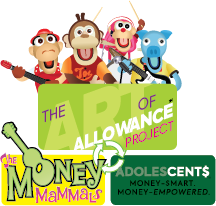
“Working to help parents raise money-smart kids.”
Hello, friends!
After teaching an Art of Allowance Academy class earlier this month, I’ve been thinking a lot about tips to help you turn an allowance into an even more effective tool.
Keeping the theme of maximizing your allowance in mind, here are this week’s 3 Ideas to Share & Save.
— 1 —
An Allowance Reflection: To kick things off, I’d like to share a little trick I recently tried with my kids that might help ensure your allowance is serving its purpose.
But first, what is the purpose of an allowance?
Allowance /ə’louəns/: An allowance is a tool you can use to help your children learn to use money as a means (not an end) to build healthy financial habits and to become money-empowered.
As your kids get older and you move them from a physical to a digital allowance, you’ll likely automate the distribution process. From time to time, consider requiring them to reflect a bit on the purpose of the money that shows up in their accounts every month.
For instance, recently I asked my daughters to watch one of our new Good Money Habits videos.
Here’s what one of them texted me afterwards:
“I want to save at least $1000 for college this year. This might mean putting more in my save [jar] when I get allowance or cash gifts. I plan on getting this money by getting a job and not putting all the money I receive into my current spending account. Then next year I will increase my goal amount and be ready for college :)”
I’m excited to see how her savings plan goes, as she doesn’t head off to college for two years. I’ll share the results with you in a later message.
I’m always on the lookout for more money-smart tips. So if you have something effective you’d like me to share, then please email me.
— 2 —
Growing Your Allowance: I invited a good friend and money maven to attend my recent Art of Allowance Academy course, as I wanted his feedback. He smartly suggested I provide a simple framework for parents to understand how an allowance will grow with their children.
So here’s a sneak peek of what I plan to incorporate into the next class:
💵 5-9 years old: The physical allowance years. You’re doling out dollars to help your kids learn from their own money experiences. You begin with $5 per week for a 5-year-old and step up that amount by a dollar each year. You can read more about the “One-Dollar-Per-Week-Per-the-Age-of-Your-Child” method in this essay and use our Allowance Kickstarter Printable as a yearly contract.
💰 10-12 years old: The allowance transition years. Since you’ll move from a Starter Allowance to the Breakthrough Allowance, your children will now receive their money monthly. This begins to prepare them for the real world dilemma of having to manage lump sums over time (you know, like a paycheck).
And with this larger allowance comes more responsibility. Your kids must now buy their own clothes, communication, food and gifts. Alternatively, you can begin with just one area of responsibility (e.g. clothes) and add the other elements over time. Read more about how the Breakthrough Allowance works in this essay.
📈 13-18 years old: The growth years. If you haven’t expanded your teens’ responsibilities to the four areas listed above, then now is a good time to do so. It is also appropriate to introduce digital allowances, talk about investing (if you haven’t already done so) and, depending on their job situations, begin paring back their allowance.
As an added bonus (Pun intended! 😉), you might also incorporate the reflection component I mentioned in the first section of today’s newsletter.
— 3 —
A Powerful Tool: An allowance is a powerful tool that provides kids the experience they need to learn about money firsthand and opens up opportunities for you to discuss finances as a family.
To that point, I’ve learned so much from the many wonderful and insightful folks I’ve interviewed on my podcast. Below you’ll find a couple of useful bits of advice.
You can use an allowance to teach values. Brad Klontz, author of Money Mammoth, explains:
And, of course, an allowance is your children’s money. Robin Taub, author of The Wisest Investment, clarifies:
As always, enjoy the journey!
John, Chief Mammal
P.S. Please consult with a financial or investment professional before engaging in any decisions that might affect your own financial well-being.
Like what you just read? You can sign up for the newsletter here.
